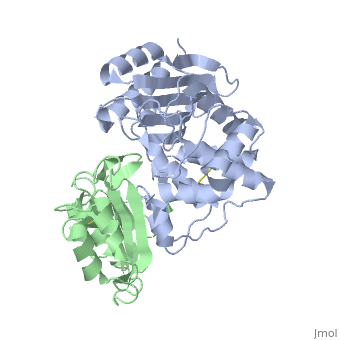The enzyme TEM1 β-lactamase (EC 3.5.2.6; and its protein inhibitor, form a . of the residues which participate in TEM1-BLIP interactions between: 1) complex of mutated BLIP (F142A) and wildtype TEM1 (lime; 1s0w); 2) complex of the wildtype BLIP/wildtype TEM1 (magenta; 1jtg); 3) unbound wildtype BLIP[1].and unbound wildtype TEM1 (1btl), these two structures colored orange). T marks residues of TEM1 and B of BLIP. The distance between TEM Glu-104 and BLIP Lys-74 is marked for the wildtype (1jtg) and mutated (F142A, 1s0w) TEM1-BLIP complex structures[2][1].
The TEM1–BLIP in the KFYEY mutant structure (1xxm) is on the wildtype complex (1jtg) structure. Mutated TEM1 is shown in red, BLIP (lime) (1xxm) , wildtype TEM1 (yellow) and BLIP (1jtg) in orange, respectively. Mutated BLIP residues (K74A, F142A, Y143A) are colored in blue-violet, TEM1 residues E104 and Y105, where mutations to alanines were performed (i.g. E104A, Y105A), are colored blue and corresponding to them alanines A104 and A105 are colored magenta in the multiple mutant complex (KFYEY). These two structures are very similar. All-atom RMS deviation (RMSD) between the structures of the wildtype and the KFYEY mutant is 0.37 Å[2]
The complex where BLIP residues of the bound structure are colored blue and of the unbound are in cyan. TEM1 residues from the bound complex are in red and from the unbound structure in yellow. BLIP and TEM1 residues are labeled blue and red. The between BLIP and TEM1 was divided into six interface clusters (, , , , , ). Superpositions of these clusters from TEM1–BLIP (complex-1jtg), TEM1 (unbound-1btl) and BLIP (unbound[1] structures are shown. of cluster C1 from TEM1-BLIP wt, mutant and unbound structures (TEM1wt-BLIPwt complex, TEM1wt-BLIPD49A, unbound TEM1 (yellow), and unbound BLIP). D49 in BLIP is located in the center of C1, surrounded by 4 TEM1 residues. The D49A mutation (i.e. removal of a side chain) does not cause structural change in the TEM1-BLIP complex.
To analyze the contribution of non-alanine mutations, E104Y and Y105N in the TEM1 protein were constructed. These residues are polar and have a similar size, hence no major structural changes are expected for these mutants. The complex structure of TEM1 E104Y-Y105N (TEM1YN) with BLIPwt was solved (2b5r). The YN mutation caused only small reduction of binding energy (4.2 kJ/mol), which is slightly less then that obtained for the alanine substitutions of these residues. The of TEM1wt-BLIPwt (yellow) complex (1jtg; TEM1 colored in magenta; BLIP in yellow) with TEM1YN (colored in lime) - BLIPwt (pink) complex (2b5r). Only a (colored orange) in was observed. But, these small changes in TEM1 sequence lead to a major local of the between residues 46–53 in BLIP (yellow). This rearrangement of the loop is not observed in the unbound BLIP structure. This shows that the rearrangement of BLIP was caused by the TEM1 mutations, resulting in a new low energy state. of residues in wt and mutant complexes near the BLIP 46-53 loop. TEM1 wt E104 and Y105 are colored cyan, while mutant E104Y and Y105N are colored orange. BLIP residues colored in blue and red in the wt and mutant complexes[3].
See also Promiscuous Protein Binding as a Function of Protein Stability

